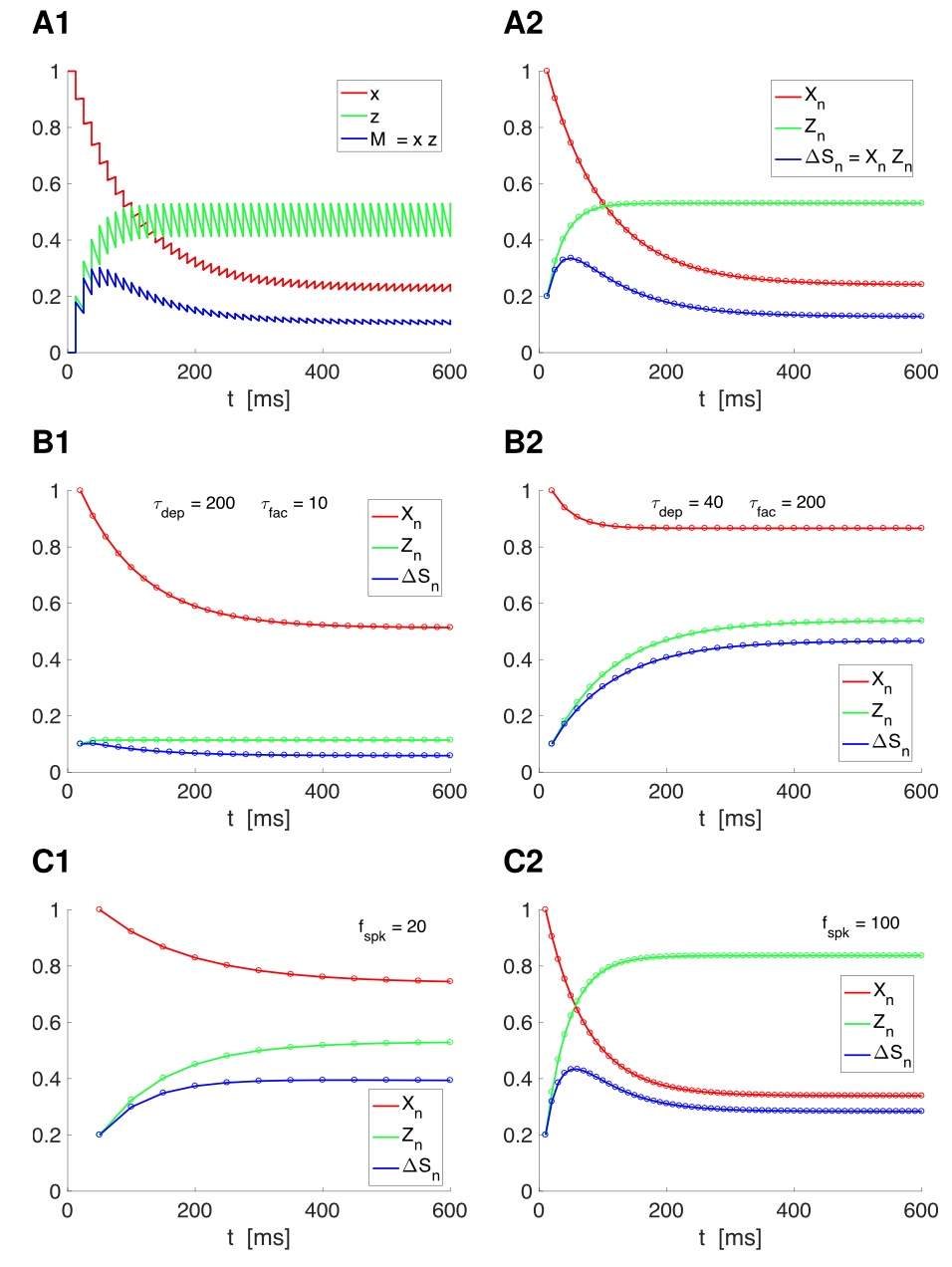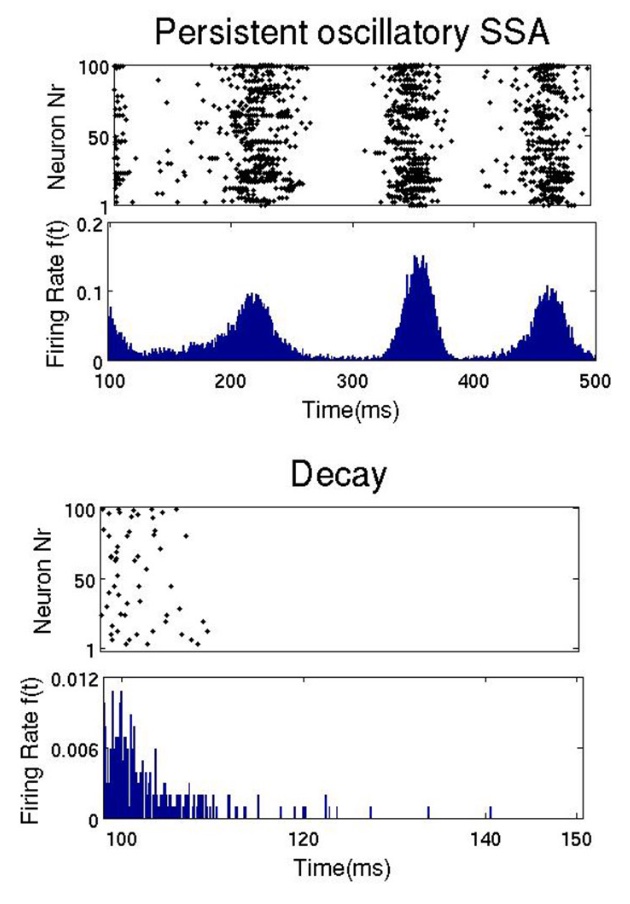Research
Highlighted

Theta and gamma rhythmic coding through two spike output modes in the hippocampus during spatial navigation.
Cell Reports
·
29 Aug 2023
·
pubmed:37540599
We examined how hippocampal neurons switch between generating single spikes and bursts of spikes and whether they convey different information. We found that burst spikes are associated with encoding an animal’s position as it enters a place field, linked to theta rhythms, while single spikes are related to exiting a place field and connected to gamma rhythms. These spiking patterns are influenced by the properties of neurons and input frequency, suggesting they perform distinct computations for spatial behavior.
All
2023

The Roles of Potassium and Calcium Currents in the Bistable Firing Transition.
Brain Sciences
·
20 Sep 2023
·
pubmed:37645875
This study investigates brain firing patterns, specifically the shift from regular spiking to burst firing in cortical neurons. It focuses on the role of potassium and calcium ion channels under various conditions. Findings suggest that slow potassium currents are vital for high-synchronous activities and spike-to-burst transitions. Bistable dynamics in neuronal networks underlie this transition, offering insights for potential pharmacological interventions to move epileptic brains from pathological bursting to healthier states.

Theta and gamma rhythmic coding through two spike output modes in the hippocampus during spatial navigation.
Cell Reports
·
29 Aug 2023
·
pubmed:37540599
We examined how hippocampal neurons switch between generating single spikes and bursts of spikes and whether they convey different information. We found that burst spikes are associated with encoding an animal’s position as it enters a place field, linked to theta rhythms, while single spikes are related to exiting a place field and connected to gamma rhythms. These spiking patterns are influenced by the properties of neurons and input frequency, suggesting they perform distinct computations for spatial behavior.
2022

Temporal filters in response to presynaptic spike trains: interplay of cellular, synaptic and short-term plasticity time scales.
Journal of computational neuroscience
·
23 Jul 2022
·
pubmed:35869381
We investigate how neurons filter and code sensory inputs using temporal filters. Short-term plasticity (STP) and various processes influence these filters. We develop mathematical tools to understand their generation and extend the findings to complex networks.

Oscillations and variability in neuronal systems: interplay of autonomous transient dynamics and fast deterministic fluctuations.
Journal of computational neuroscience
·
02 Jun 2022
·
pubmed:35653072
We investigate how rapidly fluctuating signals interact with neuronal properties, generating varied and coherent responses. Using linear and non-linear models, we explore the effects of piecewise constant inputs. We find that sustained oscillations and variability arise from the interaction between inputs and intrinsic cell dynamics, independent of input stochasticity.

The voltage and spiking responses of subthreshold resonant neurons to structured and fluctuating inputs: persistence and loss of resonance and variability.
Biological cybernetics
·
17 Jan 2022
·
pubmed:35038010
We analyze neuronal responses to oscillatory currents and synaptic-like inputs. Resonant cells exhibit selective resonance. Conductance-based inputs are attenuated compared to current-based inputs. Variability arises from different input orderings. Poisson-distributed synaptic inputs show attenuated responses. Our findings contribute to understanding oscillatory activity and network resonance.
2020

Modeling Hippocampal CA1 Gabaergic Synapses of Audiogenic Rats.
International journal of neural systems
·
14 Apr 2020
·
pubmed:32285725
WARs, genetically susceptible to sound-induced seizures, exhibit different GABAergic inhibitory postsynaptic current (IPSC) distributions compared to Wistar rats. Our computational model suggests two populations of GABAergic synapses in WARs, with reduced release frequency in a subset. This finding may contribute to their seizure susceptibility.

Optimal Interplay between Synaptic Strengths and Network Structure Enhances Activity Fluctuations and Information Propagation in Hierarchical Modular Networks.
Brain sciences
·
10 Apr 2020
·
pubmed:32290351
We study activity propagation in modular spiking networks. Optimal information flow occurs with increased synaptic strength or number of modules. Population-level and pairwise information propagation show different patterns. Increasing synaptic strength and modules enhance information transmission.
2019

Asymmetrical voltage response in resonant neurons shaped by nonlinearities.
Chaos (Woodbury, N.Y.)
·
01 Oct 2019
·
pubmed:31675799
High-amplitude oscillatory currents induce asymmetric voltage responses in neurons due to nonlinearities in ionic currents and the voltage equation. Geometrical factors and time-scale separation contribute to these asymmetries. Surprising frequency-dependent patterns emerge in the gating variables of the currents. Our findings shed light on the ionic mechanisms involved in oscillatory information processing by neurons.
2018

Firing properties of ventral medullary respiratory neurons in sino-aortic denervated rats.
Experimental physiology
·
11 Dec 2018
·
pubmed:30427561
Sino-aortic denervation (SAD) in rats alters breathing patterns without affecting sympathetic activity or arterial pressure. We observed prolonged inspiration, increased variability in late-inspiratory neurons, and reduced frequency in pre-inspiratory/inspiratory neurons. These findings suggest a timing imbalance in the respiratory network of SAD rats, impacting presympathetic neuron modulation after baroreceptor afferent removal.

Intrinsic and synaptic properties of hippocampal CA1 pyramidal neurons of the Wistar Audiogenic Rat (WAR) strain, a genetic model of epilepsy.
Scientific reports
·
10 Jul 2018
·
pubmed:29991737
In our study on epilepsy, we examined the electrical properties and synaptic transmission in CA1 pyramidal neurons of the dorsal hippocampus in a genetic model, the Wistar Audiogenic Rat (WARs). We found reduced GABAergic neurotransmission in the dorsal hippocampus of WARs, leading to increased susceptibility to limbic seizures observed during audiogenic kindling.

Dynamics of spontaneous activity in random networks with multiple neuron subtypes and synaptic noise : Spontaneous activity in networks with synaptic noise.
Journal of computational neuroscience
·
19 Jun 2018
·
pubmed:29923159
We studied spontaneous cortical population activity in networks of spiking neurons. By adjusting inhibitory synaptic strength and synaptic noise, we identified different activity patterns. Noise transformed transient patterns into persistent ones. Networks with strong inhibition and moderate noise showed intermittent switches between oscillatory and quiescent states, resembling cortical states. Our findings reveal mechanisms underlying cortical activity at multiple scales.

Interplay of activation kinetics and the derivative conductance determines resonance properties of neurons.
Physical review. E
·
01 Apr 2018
·
pubmed:29758644
Resonance in neurons with hyperpolarization-activated current (Ih) is determined by the biophysical properties of Ih, specifically the derivative conductance (GDer) and current activation kinetics (τh). The presence and frequency of resonance are controlled by GDer and τh, and their increase leads to enhanced resonance. Voltage dependence of GDer makes resonance voltage-dependent. These findings provide insights into predicting and explaining resonance properties in neurons with Ih.

Self-Consistent Scheme for Spike-Train Power Spectra in Heterogeneous Sparse Networks.
Frontiers in computational neuroscience
·
02 Mar 2018
·
pubmed:29551968
We determine numerically from an iterative single-neuron simulation spontaneous cortical population activity in networks of spiking neurons with heterogeneous populations of different cellular and connection parameters.

Non-Decaying postsynaptics potentials and delayed spikes in hippocampal pyramidal neurons generated by a zero slope conductance created by the persistent Na
Channels (Austin, Tex.)
·
01 Jan 2018
·
pubmed:29380651
The persistent sodium current (INaP) prolongs EPSP decay by increasing the membrane time constant. In the zero slope conductance region, non-decaying EPSPs are observed in CA1 hippocampal pyramidal cells. These EPSPs and delayed spikes are abolished by Na+ channel block and occur in response to small amplitude aEPSCs. This suggests that INaP enhances synaptic integration in distal dendritic regions.
2016

Mechanisms of Self-Sustained Oscillatory States in Hierarchical Modular Networks with Mixtures of Electrophysiological Cell Types.
Frontiers in computational neuroscience
·
23 Mar 2016
·
pubmed:27047367
In a diverse neuron network, global activity fluctuates between intense periods and low levels, resembling cortical “up” and “down” states. The distribution of membrane recovery variable plays a key role in initiating and stopping activity. Neuron behavior is more influenced by the presynaptic environment than their formal types.
2014

Sustained oscillations, irregular firing, and chaotic dynamics in hierarchical modular networks with mixtures of electrophysiological cell types.
Frontiers in computational neuroscience
·
02 Sep 2014
·
pubmed:25228879
The cerebral cortex exhibits spontaneous neural activity without external input. Using computer simulations, we studied the mechanisms behind this activity in hierarchical modular networks. Our models replicated experimental observations of irregular firing and oscillatory patterns. The activity duration depended on initial conditions and network characteristics, highlighting the impact of both structure and neuron types on cortical activity.